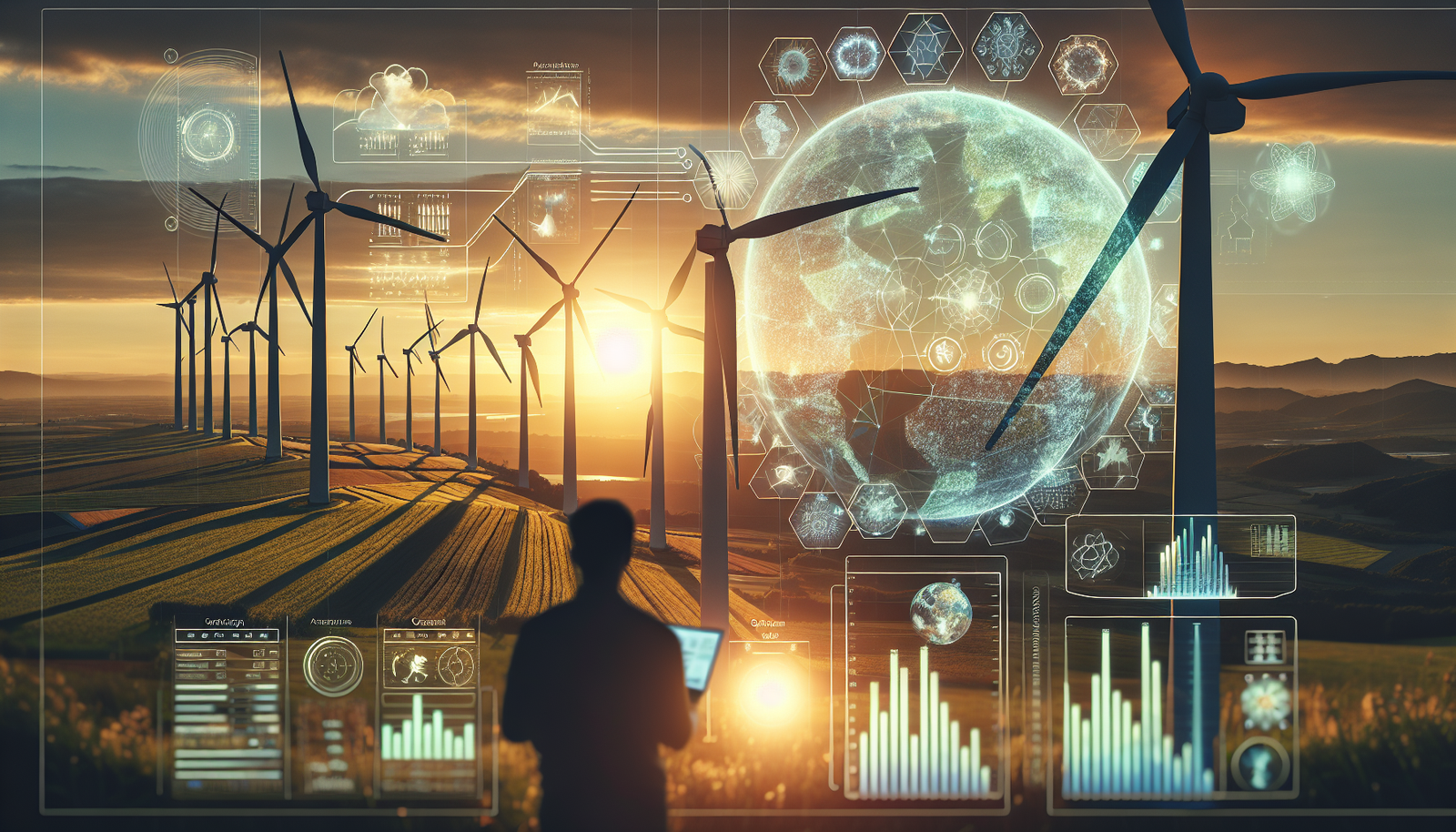Understanding AI in Climate Science
Artificial Intelligence (AI) has emerged as a critical tool in the arsenal against climate change, offering unprecedented capabilities in data analysis and predictive modeling. One of the primary ways AI aids climate science is through predictive modeling. These models help scientists anticipate climate patterns, assess risks, and plan mitigation strategies by analyzing vast datasets that would be impossible for humans to process manually.
AI’s impact is further amplified through its applications in energy efficiency and management. For instance, AI algorithms can optimize the operation of power plants and distribution grids, significantly reducing energy waste. By predicting energy demand more accurately, these systems ensure that energy production aligns closely with consumption, minimizing excess production and lowering carbon emissions. The table below highlights some key areas where AI contributes to energy efficiency:
| Application | AI Contribution |
|---|---|
| Smart Grids | Real-time data analysis for optimized energy distribution |
| Building Management | Automated climate control systems for reduced energy consumption |
| Renewable Energy | Predictive maintenance and operational efficiency |
Moreover, AI facilitates the optimization of renewable energy sources, such as solar and wind power. By analyzing weather patterns and historical data, AI systems can predict energy outputs and adjust operations to maximize efficiency. This not only makes renewables more reliable but also more competitive compared to traditional energy sources. An ul of AI-driven advancements in this field includes:
- Enhanced accuracy in weather forecasting for better energy planning.
- Real-time monitoring of energy production to reduce downtime.
- Improved storage solutions through predictive analysis of energy needs.
Overall, the integration of AI in climate science not only boosts our understanding of climate dynamics but also empowers us to devise more effective strategies for combating climate change. As AI technology continues to evolve, its role in climate science is expected to expand, yielding even more sophisticated tools and solutions for a sustainable future.
AI-Powered Climate Prediction Models
Artificial Intelligence has become a cornerstone in advancing climate prediction models, offering unprecedented accuracy and efficiency. By leveraging vast datasets, AI algorithms can identify complex patterns and correlations that traditional models might miss. These AI-driven models are crucial for anticipating climate-related phenomena, from temperature fluctuations to extreme weather events. One of the significant advantages of AI models is their ability to process and analyze data from diverse sources such as satellite imagery, meteorological sensors, and historical climate data.
The integration of AI in climate prediction is not just about enhanced accuracy but also about speed. Traditional climate models can take significant time to process the data, whereas AI models can do so in a fraction of the time. This rapid processing capability allows for more frequent updates and real-time predictions, which are essential in mitigating the impacts of climate change. For instance, AI models have been instrumental in predicting hurricane paths and intensity, enabling better preparedness and resource allocation.
Moreover, AI-powered climate prediction models have been shown to excel in predictive modeling through the use of machine learning techniques such as neural networks and deep learning. These techniques allow for the creation of models that can learn and improve over time, enhancing their predictive power. A recent study demonstrated that AI models could predict temperature changes with an accuracy of up to 90%, far surpassing traditional methods. This is achieved by training the models on historical data and continuously updating them with new data, ensuring they remain relevant and accurate.
AI’s role in climate prediction also extends to its ability to simulate and predict potential future scenarios. This capability is vital for policymakers and researchers, as it provides insights into the potential long-term impacts of climate change and the effectiveness of mitigation strategies. By simulating various scenarios, AI models can help identify the most effective actions to reduce emissions and adapt to changing climate conditions. In summary, AI-powered climate prediction models are not just tools for forecasting but are critical components in the global effort to combat climate change.
Energy Efficiency Through AI
Artificial Intelligence is significantly enhancing energy efficiency across various sectors by optimizing consumption and reducing waste. One of the primary ways AI achieves this is through smart grid technology. By utilizing AI algorithms, smart grids can analyze vast amounts of data from energy consumption patterns, predicting demand and adjusting supply accordingly. This not only minimizes energy waste but also reduces costs for providers and consumers alike.
In addition to smart grids, AI is transforming building management systems to improve energy efficiency. AI-powered systems can monitor and control lighting, heating, ventilation, and air conditioning (HVAC) in real-time. For instance, AI can adjust HVAC settings based on occupancy data, weather forecasts, and even the time of day, ensuring that energy is not wasted when spaces are unoccupied or when natural light can be utilized.
| Energy Efficiency Application | AI Technology Used | Impact |
|---|---|---|
| Smart Grid Management | Machine Learning | Reduced Energy Waste |
| Building Automation | Predictive Analytics | Optimized Energy Use |
| Industrial Processes | AI Sensors | Increased Efficiency |
Moreover, AI is playing a crucial role in optimizing industrial processes. By deploying AI sensors and analytics, industries can monitor equipment performance and predict maintenance needs before failures occur, leading to a more efficient use of resources. This predictive maintenance reduces downtime and energy consumption, further contributing to sustainability goals.
Ultimately, the integration of AI into energy systems represents a significant step forward in achieving global energy efficiency targets. As AI technology continues to evolve, its applications are likely to expand, offering even more sophisticated solutions for energy conservation and management.
AI in Renewable Energy Optimization
Artificial Intelligence (AI) is revolutionizing the renewable energy sector by optimizing the production and consumption of clean energy sources such as solar, wind, and hydroelectric power. Through advanced data analytics and machine learning algorithms, AI systems can predict energy production and demand with high accuracy, allowing for more efficient energy distribution and reduced waste.
One of the key applications of AI in renewable energy is predictive maintenance of energy infrastructure. By continuously monitoring equipment performance and identifying potential failures before they occur, AI helps reduce downtime and maintenance costs. This is crucial in wind farms, where turbines are often located in remote areas. AI algorithms analyze data from sensors installed on turbines to predict mechanical issues, ensuring that maintenance is conducted proactively.
Moreover, AI enhances the optimization of energy storage systems. Energy storage is critical for balancing supply and demand, especially with the intermittent nature of renewable energy sources. AI models can forecast energy usage patterns and optimize the charging and discharging cycles of batteries, maximizing efficiency and lifespan.
| Renewable Energy Source | AI Application | Benefits |
|---|---|---|
| Solar Power | Predictive Analytics | Improved Energy Yield |
| Wind Power | Predictive Maintenance | Reduced Downtime |
| Hydroelectric Power | Load Forecasting | Efficient Water Management |
AI also plays a significant role in the integration of renewable energy into the power grid. By analyzing vast amounts of data from diverse sources, AI systems can predict fluctuations in energy production and consumption, enabling grid operators to make informed decisions. This results in a more stable and reliable power supply, minimizing the risk of blackouts and reducing greenhouse gas emissions.
AI-Driven Carbon Capture Technologies
Carbon capture technologies are rapidly evolving, and AI is at the forefront of enhancing their efficiency and effectiveness. These technologies aim to capture carbon dioxide emissions from industrial sources and either store them underground or repurpose them for other uses. AI algorithms assist in optimizing the capture process, identifying the most effective materials and methods for capturing carbon, and predicting the long-term stability of stored carbon dioxide.
Machine learning models play a crucial role in analyzing vast datasets related to carbon capture. These models can simulate various capture scenarios, helping researchers understand which techniques yield the highest capture rates while minimizing costs. For instance, AI can predict how different chemical solvents will react under various conditions, enabling the development of more efficient capture materials.
Moreover, AI-driven technologies are being used to monitor and control carbon capture operations in real time. These systems utilize sensors and data analytics to ensure that capture processes operate at peak efficiency, reducing emissions more effectively. The integration of AI in carbon capture not only enhances performance but also contributes to significant cost reductions, making these technologies more accessible and scalable.
| AI Application | Impact on Carbon Capture |
|---|---|
| Predictive Modeling | Optimizes process efficiency and identifies best materials. |
| Real-Time Monitoring | Enhances operational control and reduces emissions. |
| Data Analytics | Improves cost-effectiveness and scalability of technologies. |
AI for Sustainable Agriculture
Artificial Intelligence (AI) is revolutionizing sustainable agriculture by enhancing productivity and minimizing environmental impact. AI-driven technologies provide farmers with precise tools for crop management, pest control, and resource optimization. With the growing need to feed an ever-increasing global population, AI offers innovative solutions to ensure food security while maintaining ecological balance.
One of the significant applications of AI in agriculture is predictive analytics. By analyzing vast datasets including weather patterns, soil conditions, and crop performance, AI systems can forecast agricultural trends and outcomes with remarkable accuracy. This helps farmers make informed decisions about planting, harvesting, and resource allocation.
| AI Application | Benefits |
|---|---|
| Precision Farming | Increases yield by optimizing resource use such as water and fertilizers. |
| Automated Pest Control | Reduces chemical usage by identifying and targeting pest infestations. |
Moreover, AI contributes to energy efficiency in agriculture by optimizing the use of machinery and reducing fuel consumption. Machine learning algorithms are used to design efficient irrigation systems that conserve water and reduce waste. AI also supports renewable energy integration in farming operations, further reducing the carbon footprint.
- AI enables real-time monitoring of crop health and soil conditions through sensors and drones.
- Advanced image recognition software can identify diseases and nutrient deficiencies early.
- AI-powered robots assist in planting, weeding, and harvesting, enhancing efficiency.
In summary, AI is a critical component in the evolution of sustainable agriculture. Through predictive modeling and data-driven insights, AI not only enhances productivity but also promotes environmental stewardship, ensuring a sustainable future for global food production.
AI Applications in Water Management
Artificial Intelligence (AI) is revolutionizing water management, a critical component of climate change mitigation strategies. AI technologies are being employed to optimize water usage, enhance the efficiency of water distribution systems, and predict water-related challenges. By leveraging vast amounts of data, AI systems can provide insights that help in making informed decisions regarding water conservation and distribution. For instance, AI-driven predictive analytics can forecast water demand and supply patterns, thus ensuring a balanced and efficient distribution of this vital resource.
One of the key applications of AI in water management is in the detection of leaks and wastage in water distribution networks. Through the use of machine learning algorithms and sensor data, AI can identify anomalies in water flow that may indicate leaks. This enables quick response and repair, significantly reducing water loss. Additionally, AI systems can optimize irrigation practices in agriculture, ensuring that crops receive the right amount of water at the right time, thus enhancing water use efficiency.
AI also plays a crucial role in the management of water resources through real-time monitoring and analysis. By integrating AI with Internet of Things (IoT) devices, water quality and availability can be continuously monitored. This is particularly valuable in regions prone to droughts or floods, where timely data can support proactive management strategies. The table below illustrates the potential impact of AI on water management:
| AI Application | Impact on Water Management |
|---|---|
| Leak Detection | Reduces water loss and saves costs |
| Irrigation Optimization | Improves crop yield and conserves water |
| Real-time Monitoring | Enhances water resource management and planning |
In conclusion, AI’s integration into water management systems not only addresses immediate efficiency and conservation concerns but also contributes to long-term sustainability goals. As climate change continues to impact global water resources, the role of AI in innovating water management solutions will become increasingly indispensable.
AI in Urban Planning for Sustainability
Artificial Intelligence (AI) is revolutionizing urban planning by offering innovative solutions to enhance sustainability in cities. As urban areas continue to grow, the need for sustainable planning becomes increasingly critical. AI-powered tools can analyze vast amounts of data to optimize urban layouts, reduce energy consumption, and improve transportation systems. By integrating AI into urban planning, cities can become more efficient, reduce their carbon footprint, and provide a better quality of life for their residents.
One of the key applications of AI in urban planning is in the optimization of energy usage within cities. AI algorithms can assess patterns of energy consumption and identify areas where energy efficiency can be improved. For example, AI can be used to control lighting and heating systems in smart buildings, ensuring that energy is used only when necessary. This not only reduces energy wastage but also significantly cuts down on greenhouse gas emissions.
Moreover, AI can enhance the development of transportation networks by analyzing traffic patterns and predicting future congestion points. This allows city planners to design more efficient public transportation systems and reduce the reliance on fossil fuels. AI can also assist in the planning of electric vehicle charging infrastructure, making sustainable transportation more accessible to the public.
Urban planning for sustainability can greatly benefit from AI’s ability to process and analyze complex datasets. By leveraging AI’s predictive modeling capabilities, planners can visualize the long-term impacts of their decisions, ensuring that urban growth aligns with environmental conservation goals. In this regard, AI acts as a critical tool in creating sustainable cities that are resilient to the challenges posed by climate change.
AI and Climate Change Policy Formulation
Artificial Intelligence (AI) is increasingly becoming a cornerstone in the formulation of climate change policies. By leveraging vast datasets and sophisticated algorithms, AI enhances the ability to predict climate trends and assess the potential impacts of proposed policies. This capability allows policymakers to make data-driven decisions that can lead to more effective climate action. One of the key areas where AI is making a significant impact is in the modeling of greenhouse gas emissions and their long-term effects on global temperatures.
AI tools can analyze complex climate models to provide insights that are crucial for policy formulation. For instance, AI can simulate the outcomes of various policy scenarios, helping governments understand the potential economic and environmental impacts before implementation. This predictive capability is essential for crafting policies that not only aim to reduce emissions but also consider economic sustainability.
AI also plays a crucial role in optimizing the allocation of resources for climate change mitigation efforts. By using machine learning algorithms, policymakers can identify which regions or sectors would benefit most from certain interventions, ensuring that resources are utilized efficiently. Below is an example of how AI can assist in the allocation of resources:
| Region | Resource Allocation | Expected Impact |
|---|---|---|
| Northern Europe | Increased investment in renewable energy | Reduction in carbon footprint by 15% |
| Southeast Asia | Development of flood defenses | Decrease in flood-related damages by 20% |
Moreover, AI enhances the transparency and accountability of climate policies. By providing a clear analysis of data and policy impacts, AI tools enable stakeholders, including the public, to better understand and evaluate government actions. This transparency is vital for building trust and ensuring that climate policies are both effective and equitable.
AI’s Role in Environmental Monitoring
The integration of Artificial Intelligence in environmental monitoring represents a significant leap forward in how we understand and interact with our natural surroundings. AI technologies are increasingly being utilized to collect, analyze, and interpret environmental data with unprecedented accuracy and speed. By leveraging machine learning algorithms, AI can process vast amounts of data from various sources such as satellites, drones, and ground sensors to detect patterns and anomalies that might otherwise go unnoticed. This capability is particularly crucial in tracking changes in forest cover, monitoring air and water quality, and predicting natural disasters.
One of the most transformative applications of AI in environmental monitoring is in the area of real-time data analysis. Traditional methods of data collection and analysis often involve significant time lags, which can impede timely decision-making. AI, however, enables the real-time processing of data, allowing for immediate insights and actions. For example, AI-powered systems can analyze satellite imagery to track deforestation in real-time, providing alerts to authorities who can then take swift action to mitigate illegal logging activities. This immediacy is vital for proactive environmental conservation efforts.
Furthermore, AI enhances the precision of environmental monitoring through advanced predictive analytics. By analyzing historical and current data, AI systems can predict future environmental conditions and trends. This ability is especially beneficial in the context of climate change, where accurate predictions of weather patterns, sea level rise, and biodiversity shifts are essential for developing effective mitigation strategies. AI’s predictive power is supported by sophisticated models that continuously learn and improve, ensuring that predictions become more reliable over time.
| AI Application | Function | Impact |
|---|---|---|
| Satellite Imagery Analysis | Tracks changes in land use and forest cover | Improves deforestation monitoring and prevention |
| Air Quality Monitoring | Analyzes pollutants and emissions | Enhances public health and policy-making |
| Predictive Weather Modeling | Forecasts weather patterns and extreme events | Supports disaster preparedness and response |
In conclusion, AI’s role in environmental monitoring is multifaceted and continually evolving. As AI technologies advance, their capacity to provide nuanced and actionable insights into environmental health will only increase, making them indispensable tools in the fight against climate change and environmental degradation.
Challenges and Ethical Considerations
As artificial intelligence is increasingly integrated into climate change mitigation strategies, several challenges and ethical considerations arise. One of the primary challenges is the availability and quality of data. AI models rely heavily on large datasets to make accurate predictions and recommendations. However, in many regions, especially in developing countries, there is a lack of comprehensive environmental data. This data scarcity can lead to biased models that do not accurately represent global climate dynamics.
Another significant challenge is the energy consumption of AI technologies themselves. While AI can optimize energy usage in industries and homes, the computational power required to train large AI models is substantial. This creates a paradox where the tools used to mitigate climate change may also contribute to it. Addressing this requires the development of more energy-efficient algorithms and increased use of renewable energy in data centers.
From an ethical standpoint, transparency and accountability in AI systems are critical. There is an ongoing debate about the “black box” nature of AI, where decision-making processes are not entirely transparent to users. This lack of transparency can lead to mistrust and resistance in adopting AI-driven solutions for climate change. Additionally, there is the issue of equity; the benefits of AI should be accessible to all, not just wealthy nations or corporations. Ensuring that AI technologies are developed and deployed in a way that promotes global equity and inclusivity is essential.
The ethical implications of AI in climate change mitigation are further complicated by issues of privacy and surveillance. For instance, AI systems that monitor environmental changes might inadvertently collect personal data, leading to privacy concerns. Ensuring that AI applications comply with privacy laws and respect individual rights is crucial in maintaining public trust. The following table summarizes some of the key challenges and ethical considerations related to AI in climate change mitigation:
| Challenge | Ethical Consideration |
|---|---|
| Data Scarcity | Biased Models |
| High Energy Consumption | Environmental Impact |
| Transparency Issues | Trust and Accountability |
| Global Equity | Access and Inclusivity |
| Privacy Concerns | Surveillance Risks |
Future Prospects of AI in Climate Mitigation
As the world grapples with the escalating impacts of climate change, the future prospects of AI in climate mitigation appear increasingly promising. AI technologies are anticipated to revolutionize how we forecast climate patterns, optimize energy consumption, and enhance the efficiency of renewable energy sources. One of the most significant advantages of AI lies in its capability to process vast amounts of data at unprecedented speeds, enabling more accurate predictive modeling. This can lead to improved climate change models that help policymakers make informed decisions.
Moreover, AI’s role in enhancing energy efficiency cannot be overstated. By employing machine learning algorithms, we can better understand consumption patterns and devise strategies to reduce energy wastage. For instance, smart grids powered by AI can dynamically adjust to the supply and demand of electricity, thus minimizing energy loss. This technology can be crucial in integrating renewable energy sources into the grid, ensuring a stable and reliable power supply. The table below highlights some key areas where AI is expected to make significant contributions:
| Area of Impact | AI Application | Expected Outcome |
|---|---|---|
| Predictive Modeling | Advanced climate simulations | Improved accuracy of climate forecasts |
| Energy Efficiency | Smart grid management | Reduced energy wastage |
| Renewable Optimization | Resource allocation algorithms | Enhanced renewable energy integration |
In addition to these advancements, AI is poised to facilitate the optimization of renewable energy resources. Through sophisticated algorithms, AI can determine the most efficient allocation of resources such as wind and solar power, maximizing their output and reliability. For example, AI can predict weather conditions that impact renewable energy production and adjust operations accordingly. This not only boosts the efficiency of renewable technologies but also reduces reliance on fossil fuels, thereby lowering greenhouse gas emissions.
Looking ahead, the integration of AI with emerging technologies such as the Internet of Things (IoT) and blockchain could further accelerate climate mitigation efforts. These technologies can enhance data collection and transparency, ensuring that AI systems have access to real-time information for better decision-making. As such, the continued development and deployment of AI hold the potential to drive transformative changes in our approach to climate change mitigation.



